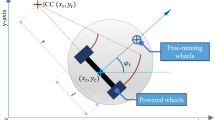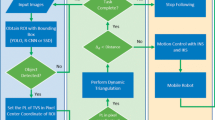Abstract
This paper proposes an approach that solves the Robot Localization problem by using a conditional state-transition Hidden Markov Model (HMM). Through the use of Self Organized Maps (SOMs) a Tolerant Observation Model (TOM) is built, while odometer-dependent transition probabilities are used for building an Odometer-Dependent Motion Model (ODMM). By using the Viterbi Algorithm and establishing a trigger value when evaluating the state-transition updates, the presented approach can easily take care of Position Tracking (PT), Global Localization (GL) and Robot Kidnapping (RK) with an ease of implementation difficult to achieve in most of the state-of-the-art localization algorithms. Also, an optimization is presented to allow the algorithm to run in standard microprocessors in real time, without the need of huge probability gridmaps.
Similar content being viewed by others
Explore related subjects
Discover the latest articles, news and stories from top researchers in related subjects.References
Thrun, S., Burgard, W., Fox, D.: Probabilistic Robotics. MIT Press (2005)
Llarena, A.: Here comes the robotic brain. Trends in intelligent robotics. Commun. Dependability Qual. Manag. 103(2), 114–121 (2010)
Choi, W.S., Oh S.Y.: Range sensor-based robot localization using neural network. In: International Conference on Control, Automation and Systems, pp. 230–234 (2007)
Djekoune, O., Achour, K.: Vision-guided Mobile Robot Navigation Using Neural Network. In: Proceedings of 2nd International Symposium on Image and Signal Processing and Analysis, pp. 355–361 (2001)
Janet, J.A., Gutierrez, R., Chase, T.A.: Autonomous mobile robot global self-localization using kohonen and region-feature neural networks. Journal of Robotic Systems 263–282 (1997)
Racz, J., Dubrawski, A.: Mobile Robot Localization With an Artificial Neural Network. International Workshop on Intelligent Robotic Systems IRS’94, Grenoble, France (1994)
Wang, K., Wang, W., Zhuang, Y.: Appearance-Based Map Learning for Mobile Robot by Using Generalized Regression Neural Network. ISNN (1): 834–842 (2007)
Conforth, M., Meng, Y.: An artificial neural network based learning method for mobile robot localization. Robotics automation and control, Pavla Pecherkova, Miroslav Flidr and Jindrich Dunik (Ed.), ISBN: 978-953-7619-18-3, InTech (2008)
Fox, D., Burgard, W., Thrun, S.: Markov localization for reliable robot navigation and people detection. In: Modeling and Planning for Sensor-Based Intelligent Robot Systems. Springer, Berlin (1999)
Simmons R., Koenig, S.: Probabilistic Navigation in Partially Observable Environments. IJCAI ‘95, Montreal Canada (1995)
Thrun, S., Fox, D., Burgard, W., Dellaert, F.: Robust Monte Carlo localization for mobile robots. AI 128, 99–141 (2000)
Roumeliotis, S., Bekey, G.: Bayesian estimation and Kalman filtering: A unified framework for mobile robot localization. In: Proc.2000 IEEE ICRA, 22–28 April, pp. 2985–2992 San Francisco, CA (2000)
Savage, J., Morales, M., Márquez, E.: The Use of Hidden Markov Models and Vector Quantization for Mobile Robot Localization. Robotics and Applications (RA 2005), IASTED, Boston, U.S.A.
Lu, F., Milios, E.: Robot Pose Estimation in Unknown Environments by Matching 2D Range Scans. JIRS (18), No. 3, March 1997, pp. 249–275. 9705
Crowley, J.L., Demazeau, Y.: Principles and techniques for sensor data fusion. Signal Process. 32(1–2) S. 5–27 (1993)
Diosi A., Kleeman, L.: Advanced sonar and laser range finder fusion for simultaneous localization and mapping. Proc. IROS (2004)
Elfes, A.: Using occupancy grids for mobile robot perception and navigation. Computer. 22(6):46–57 (1989)
Thrun, S., Gutmann, J.-S., Fox, D., Burgard, W., Kuipers, B.: Integrating topological and metric maps for mobile robot navigation: A statistical approach. In: Proceedings of the AAAI Fifteenth National Conference on Artificial Intelligence (1998)
Savage, J., Llarena, A., Carrera, G., Cuellar, S., Esparza, D., Minami, Y., Peñuelas, U.: ViRbot: a system for the operation of mobile robots. In: Proc. RoboCup, pp. 512–519 (2007)
Barreto, G.D.A., Araújo, A.F.R., Ritter, H.: Self-Organizing Feature Maps for Modeling and Control of Robotic Manipulators. presented at Journal of Intelligent and Robotic Systems, pp. 407–450 (2003)
Rabiner, L.R.: A tutorial on Hidden Markov models and selected applications in speech recognition. Proc. I.E.E.E. 77(2), 257–285 (1989)
Menegatti, A., Pretto, A., Scarpa, E., Pagello: Omnidirectional vision scan matching for robot localization in dynamic environments. IEEE Trans. Robot. 22(3), 523–535 (2003)
Little, J., Se, S., Lowe, D.: Vision-based mobile robot localization and mapping using scale-invariant features. Proceedings of the IEEE International Conference on Robotics and Automation (ICRA), pp. 2051–2058 (2001)
Jaynes, E.T.: Probability theory: the logic of science”, Cambridge University Press. ISBN 9780521592710 (2003)
Kailath, T.: Lectures notes on Wiener and Kalman filtering. Springer (1981)
Julier S.J., Uhlmann. J.K.: A new extension of the Kalman Filter to Nonlinear Systems. Proc. of AeroSense, The 11th Int. Symp. On Aerospace/Defense Sensing, Simulation and Controls (1997)
Julier, S.J., Uhlmann, J.K., Durrant-Whyte. H.: A new approach for nonlinear systems. In: Proceedings of the American Control Conference, pp. 1628–1632 (1995)
Jazwinski, A.H.: Stochastic processes and filtering theory. Academic Press, New York, NY (1970)
Doucet, A., de Freitas, N., Murphy, K., Russell, S.: Rao-blackwellised particle filtering for dynamic Bayesian networks. In: UAI (2000)
Viterbi, A.: Error bounds for convolutional codes and an asymptotically optimum decoding algorithm. IEEE Trans Inf Theory 13(2), 260–269 (1967)
Fortune. S.: A sweep line algorithm for Voronoi diagrams. Proceedings of the second annual symposium on Computational geometry. Yorktown Heights, New York, United States, pp. 313–322 (1986). ISBN: 0-89791-194-6
Linde, Y., Buzo, A., Gray, R.M.: An Algorithm for Vector Quantizer Design. IEEE Trans. Commun. 84–95 (1980)
Latombe, J.C.: Robot Motion Planning, 3rd edn. Kluwer, Boston (1991)
Haykin, S.: Neural Networks. A Comprehensive Foundation. 2nd edn. Prentice Hall (1999)
Liu, G. Haralick, R.M.: Two Practical Issues in Canny’s Edge Detector Implementation. In: icpr. 3,15th International Conference on Pattern Recognition (ICPR’00), vol. 3, p. 3680 (2000)
Lowe, D.: Object recognition from local scale-invariant features. In: Proceedings of the Seventh International Conference on Computer Vision(ICCV’99), September 1999, pp. 1150–1157. Kerkyra, Greece
Author information
Authors and Affiliations
Corresponding author
Rights and permissions
About this article
Cite this article
Llarena, A., Savage, J., Kuri, A. et al. Odometry-Based Viterbi Localization with Artificial Neural Networks and Laser Range Finders for Mobile Robots. J Intell Robot Syst 66, 75–109 (2012). https://doi.org/10.1007/s10846-011-9627-8
Received:
Accepted:
Published:
Issue Date:
DOI: https://doi.org/10.1007/s10846-011-9627-8




